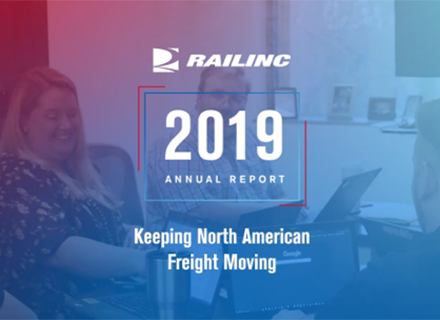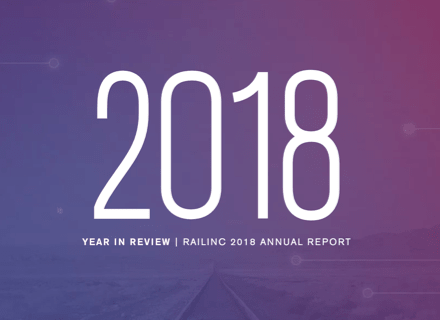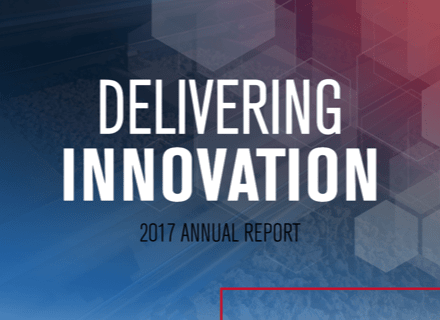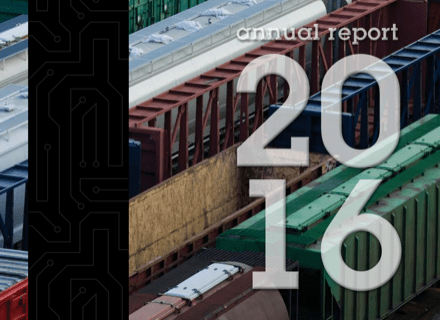




These solutions are helping to make our transportation infrastructure safer and are helping railroads and their customers deliver resources and consumer products more efficiently and at a lower cost. Railinc is the largest single source of real-time accurate interline rail data for the North American railroad system.
Providing industry stakeholders insight into the transportation health status of locomotives allows railroads to make more efficient, logic- and utilization-driven decisions. Therefore, phase 1 of Railinc’s Locomotive Management Information System (LMIS) project centered on developing a visibility solution to establish a universal determinant for locomotive capability and operability through Umler® and subsystem health status reporting.
Accomplishments in 2020 included deployment of the LMIS application, which provides critical locomotive transportation health status data and will later provide an end-to-end workflow for completing locomotive repairs. Because of the LMIS application, railroads will now have better access to locomotive health details and more control over inbound foreign locomotive capabilities. Once the repair module is implemented, the standardization will strengthen trust in the repair process, which will result in velocity enhancements and additional time and cost-savings for locomotive owners.
In phase 2 of this project, Railinc will shift its focus to the mechanical aspect of locomotives, specifically prioritizing the development of a defect and repair workflow. The LMIS gateway and repository capabilities will be developed to enable receipt of on-demand comprehensive foreign locomotive data by railroads, which they will be able to migrate into their internal locomotive management applications.
In 2020, Railinc increased the total number of wayside detectors monitored through the Detector Quality Monitoring project to four, and enhanced the scoring model to enable faster, easier detection of healthy, versus unhealthy, detectors by railroads, using data visualization tool Tableau. This advanced integration of Tableau — the first embed of Tableau into a Railinc application ever — leverages interactivity and personalization capabilities to assist railroads in isolating and addressing unhealthy detectors. Separately, Railinc also introduced a new daily email report for railroads, which each morning includes a dashboard with a high-level overview of detector performance, as well as a new industry average feature that railroads can use as a benchmark to assess how their detectors are performing comparatively. Through pivoting from solely monitoring the health of the railcar to now also monitoring the health of their detectors, railroads can continue to address derailment prevention with innovative solutions.
Railinc will begin monitoring an additional detector type in 2021, with the ultimate goal of being able to create reports that address data quality and industry alerts for all existing, and future, detectors. Looking ahead, Railinc’s work with detector quality monitoring will enable interoperability and make it easier for the industry to adapt in the future.
Accurate, precise location data is the foundation of an array of industry-critical IT solutions and initiatives, such as AskRail®, the Asset Health Strategic Initiative and real-time mileage processes. As the industry moves to adopt a data model to standardize location data across a consolidated network view of North American rail infrastructure, Railinc in 2020 achieved a key milestone toward that goal: the receipt and initial onboarding of data from all seven Class I railroads in the new, standardized Rail Industry GIS (RIGIS) format. Additional project accomplishments this year included: improvements in data quality to ensure more accurate and sustainable mileage calculations for industry processes; the successful completion of the RIGIS Portal Positive Train Control (PTC) pilot, which explored using RIGIS to document and share PTC GIS information to support PTC interoperability; and, enhancements to GIS data change management workflows in the Chicago Clear Path™ System.
Building upon 2020’s work, 2021 will see the adoption of the data model and onboarding of all requisite data from Class I railroads, as well as significant development of the RIGIS Platform. Data quality improvement initiatives will be expanded to incorporate Class I updates to relevant Industry Reference Files (IRFs) and refine workflows to support updates to the Federal Railroad Administration’s North American Rail Network (NARN). Further assessment of the potential benefits of utilizing the RIGIS Portal to support PTC interoperability will continue, as well as the implementation of Clear Path™ change management, with additional railroads prepared to participate in this process.
This year’s deliverables for the cloud migration project helped further three overarching goals:
Networking, infrastructure, security and operations were the prevailing themes of Railinc’s 2020 work to support cloud foundation development. Key advancements this year included: the adoption of Amazon Web Services to deploy and operate applications in the cloud securely; the construction of a physical network pipe that facilitates seamless communication between on-premise and cloud environments, circumventing potential bandwidth-related issues; and the introduction of Terraform, which relieves Railinc of considerable manual labor when establishing infrastructure in the cloud environment by allowing engineers to do so through writing code.
In 2020, Railinc began moving its first applications to the cloud in an effort to test the process and identify and resolve any challenges that could arise from the variations in interactions with different applications running in cloud. In addition to the successful migration of a Tier I application, AAR Embargo System, Railinc was also able to migrate FindUs.Rail and the Clear Path™ System, among other applications, to the cloud this year.
In preparation for future migrations, approximately 60 application components were modernized in accordance with our minimum cloud viable architecture benchmarks in 2020. These improvements will facilitate a smooth transition when it is time for the application to be hosted in the cloud.
Railinc looks forward to providing customers with a faster, more agile experience, while maintaining the same level of networking capabilities and security that customers depend on daily, through cloud computing. More than 100 applications from across the spectrum of Railinc product families are scheduled to migrate to the cloud in 2021.
These solutions are helping to make transportation infrastructure safer and are helping railroads and companies deliver resources and consumer products more efficiently and at a lower cost. Railinc is the largest single source of real-time accurate interline rail data for the North American railroad system.
This project allowed for more consistency in mileage data, supporting regulatory modernization efforts. This was achieved through improved data analysis, data quality and development work for utilization of movement and location events to achieve the electronic air brake slip (eABS) and mileage.
This project allowed the industry to prioritize critical maintenance work to reduce derailments by generating new derailment data streams and improved analysis of derailment data. This project completed the electronic data reporting of MD-12 (axle) and MD-500 (side frame/bolster) data and worked with the Wheels, Axles, Bearings & Lubrication Committee (WABL), Coupling Systems and Truck Castings Committee (CSTCC), and the Asset Health Strategy Committee (AHSC) to facilitate industry action when trending patterns of component and equipment failures are identified.
Improved the data quality for wayside detector data, which drives maintenance decisions to increase safety. This continued the work from 2019 — adding data validation capabilities to the inspection quality platform. The system continued to monitor detector data and inform detector owners of potential issues.
This project shared images from machine vision systems to support and enable algorithm vendors to more quickly access images to develop new algorithms to address problems. This project created a platform for sample images to be persisted, based on agreed standards.
This project reduced MLPB monthly billing delays by automating exception handling, correcting data inputs, improving reporting and system edits and enabling pool operators to view multi-level rack asset health status.
This project allowed the industry to track cushioning unit changes and repairs, which improved repair visibility and component performance analysis. This project captured and reported cushioning units applied to equipment working with the Equipment Engineering Committee and the Asset Health Strategy Committee.
This project improved shop and repair efficiency by better identifying car and component issues through the early warning system. This project continued railroad integration of Railinc system changes to alert systems that include equipment-level tracking, location on car and prioritization of equipment alerts.
This project extended capabilities to share configuration, status, and defect information for foreign locomotives online as well as share PTC compliance and locomotive capabilities electronically as specified in bilateral run-through agreements (Phase 2 will include work to provide more detailed mechanical defect codes).
The 2020 Bad Actor Identification project allowed the industry to reduce repeat line of road failures by isolating the equipment that requires repair. It also continued to work with the Brake Systems Committee (BSC) to enhance the algorithms that identify conditions that result in failures with no cause.
This project expanded Clear Path’s ability to provide railroad personnel with a single, integrated view of terminal operations. Waybill and equipment characteristics data was added to enhance the available train information leading to better informed operating decisions. Corridor metrics and stopped train identification were also improved when the new Train ID matching solution was implemented. This leads to better informed gateway planning and faster recovery from weather-related or stopped train incidents. This project also progressed the sustainability of the Clear Path System through the automation of GIS change management and data quality measures as well as supporting improved user adoption and railroad business process integration in the Chicago Terminal.
This project examined potential additional value enhancements for the Chicago Terminal, including: mobile device support, outbound data services and potential system integration of EDI 418s.
Supported initiatives that lead to regulatory modernization, customer visibility and improved operational decision making. This project was a continuation of the multi-phased program to enable industry-wide GIS data sharing capabilities between Class I railroads, improve quality of GIS data and provision GIS sustainability to Class I railroads and other industry applications.
The 2020 ILM project built out the centralized workflow platform to support interoperable PTC system release, change, and configuration management, as well as shared knowledge documentation. This platform allows for better communication and process uniformity which increases efficiency and reduces the risk of incompatible PTC versions of assets and components operating across the network.
Increased velocity by allowing railroads to exchange the necessary diagnostic data with each other to assist in analyzing and solving PTC interoperable failure instances. The MAIN-CDX project provided a centralized data-sharing platform for all interoperable train control-equipped railroads. The 2020 project leveraged the foundation established in 2019 with additional capabilities, enabling railroads to push relevant PTC data to receiving railroads and augmenting PTC data with other industry system data. Additional integration methods, such as webservices, were also made available to the industry.
Delivered reduced cost and increased accuracy to EOT settlement participants by automating the process all the way through settlement in the Railroad Clearing House (RCH). Additional projects will improve EOT device visibility, which allows EOT managers to reduce EOT costs and increases EOT utilization.
Enhanced efficiencies and cost savings by simplifying the communications process between railroads and equipment owners. This was the second project phase of three for developing a new loading authority system that's in accordance with the new AAR Circular, OT-57. The project allowed for communications between railroads and equipment controlling entities or equipment owners and improved the interaction with the industry's contact management system, FindUs.Rail.
This project updated the forward and store system to be compliant with the EDI 8010 rail standard, which allows the industry to utilize industry-requested changes and federal regulatory requirements to the EDI 417 (waybill) and EDI 421 (trip plan) message types. The changes are collected over a two-year period from the industry to meet changing business needs and improve communications between carriers.
This project created cost savings through electronic data sharing. It expanded the usage of the file sharing platform known as the Rail Document Interchange (RDI) into the Freight Loss Data Exchange (FLDX) to turn it into a paperless process.
Enhanced ease-of-use and contributed cost savings through electronic data sharing. This project enhanced the Rate EDI Network (REN) application to increase the automated flow of rate data between industry partners, including short lines.
This project provides Class I railroads with support for eABS and regulatory modernization, including integration and data quality improvements.
This project will support specific short line and regional railroads to improve event and location accuracy.
This project will significantly increase the sharing of HBD data — which facilitates data transparency, activity and visibility for inbound trains — by developing an industry HBD suggestion model at interchanges to supplement the current subscription model. In addition, it will support separate efforts around detector quality monitoring (DQM) and future alert creation.
This project will improve equipment visibility by addressing the accuracy and quality of AEI sites, RFID tags and Umler® data, as well as through wayside detector matching and process improvements.
This project supports Class I algorithm writers by making it easier to share images with and get images from Railinc. Enhancements include robust security rules, integration support and data augmentation.
This project will support Class I railroads in reviewing and prioritizing how to address and standardize monitoring by providing an assessment of derailment data. The analysis will include reportable and non-reportable derailment data.
This project seeks to develop a repository for EPA emission data to be centrally stored and accessed. This capability will eliminate the need to maintain labels on each locomotive and engine.
Enables railroads to standardize and streamline one-time movement authority (OTMA) requests to and responses from the FRA by providing the FRA with a workflow tool that will facilitate a faster review and approval process.
Railinc will implement detector quality monitoring for hot bearing wayside detectors in phase 3 of the DQM project. This work completes the multi-phase DQM work originally prioritized by the Equipment Health Monitoring Committee (EHMC). The DQM platform identifies data quality issues (e.g., sensor failure, false readings, and sensor drift) from wayside detectors that supports detector owners to remediate problems that result in unnecessary repairs and missed defects.
This project will extend Railinc’s 2020 work to share transportation defects by including locomotive mechanical status sharing. Class I railroads can share configuration and status information electronically for foreign locomotives in interchange service resulting in increased utilization across the network. Proactive and efficient electronic communication of locomotive status data reduces emails and phone calls, as well as improves velocity.
Provides EOT managers with additional reporting tools to reduce the time needed to research EOT hire and EOT fleet management issues, along with reducing the number of overall exceptions. This project is a continuation of Railinc’s 2020 EOT work and will focus on three main themes: improved EOT event reporting; enhanced reporting functions; and the addition of a new workflow to EOT exceptions.
This project will advance Asset Health Strategy Committee (AHSC) EOTD program priorities by improving device location identification and progressing next generation EOT specifications. Through this project, Railinc will improve device visibility by mapping the location of EOTs in association to yards and along the track and automate utilization metrics in a common Equipment Assets Committee settlement/AHSC management dashboard.
This project will update Clear Path's EDI 161 message integration with participating railroads to enable digital bulletin delivery. This will reduce the amount of time a train is delayed due to missing foreign bulletins. Additionally, the Train ID information in these messages will further enhance Clear Path’s ability to track a specific train as it moves through the terminal thereby improving our corridor metrics and stopped train identification algorithm. Application workflows will also be streamlined to support extensibility of this capability beyond the Chicago terminal.
This project is the next phase of a multi-year program to enable industry-wide GIS data sharing capabilities between Class 1 railroads. The project will improve the quality of GIS data and enable change management process related to the sharing of GIS data among Class 1 railroads and to other industry applications. The railroads’ ability to share this information also improves the potential for better interoperability.
Enhancements performed on the ILM master workflow platform this year will enable the industry to oversee interoperable requirements management and test case management for interoperable configuration items (ICIs). The 2021 ILM project will focus on enhancements that support interoperable PTC system requirements management and will also begin development for industry test management to allow joint industry testing for common elements of the system, reducing redundant efforts.
This project will enable TTCI to improve efficiencies and expand the capabilities of the current Positive Train Control (PTC) braking evaluation methodology for freight and passenger operations. This will be accomplished by developing a flexible and secure application to host, execute, store and report on braking algorithm scenarios executed by TTCI.
Increases the effectiveness of REN by updating the network to be compliant with the EDI 8010 rail standard. The primary focus in 2021 will be to update the Mexican peso currency code from MXP to MXN
This project will help reduce the amount of manual data entry railroads currently perform when transmitting rates via the REN application by enhancing the user interface to simplify workflows, reduce touchpoints and improve usability for industry participants.
Facilitates effective industry communication and enables industry stakeholders to reap the full benefits of the recent EDI upgrade by updating ISS to be compliant with the EDI 8010 rail standard.
This project will allow shippers to view the last three commodities loaded in a hopper car. The last three commodities will be sourced from loaded waybills reported to Railinc over the past five years.
This project supports efforts to improve railroads’ visibility into where events are being reported. Railroads will have access to a new tool to review scenarios where reporting could be improved, as this project will create an industry event reporting scorecard, reports and supporting data.
This project serves to expand the AAR Embargo/OPSL Permit System by more deeply integrating with railroad systems and improving usability. This work will help to reduce cost by providing more options for handling empty cars during congestion, making it easier to create embargoes, easier to onboard new users and enabling the RRs to react more quickly to cancelled embargoes by adding an “all clear” functionality.
The project streamlines PTC interoperable operations and avoids manual work arounds by enabling non-EDI capable railroads to exchange train information necessary for EDI 418J.
This study will consist of a comprehensive investigation into customer information needs and potential solutions.
Our focus is always on working together with our customers and developing innovative solutions that solve our customers’ toughest challenges. In 2021, Railinc will run several proofs of concept focusing on GPS and various other sensors with the goal of evaluating how new, advanced technologies could help to transform the North American freight rail industry.
The RailSight™ Suite of Applications provides more than 11 million daily shipment and equipment management events that enable 3PLs, equipment owners and other customers to easily plan operations and respond to issues.
CarLogix optimizes railcar repair management by integrating asset health data, industry rule management and billing automation in a single system. Whether a customer repairs cars or manages maintenance for a fleet, CarLogix ensures accuracy and enhanced productivity at every step of the repair process.
Commercial Analytics products provide actionable business insights using asset, shipment, location and component data. By placing advanced business intelligence at a customer’s fingertips, Commercial Analytics products enable reduced service disruptions, improved safety, managed costs and streamlined daily operations.




“Very, very impressed with the employees who work with us, from the help desk to partners at the industry level.”- Class I Customer
“We appreciate all the support personnel so much and they make a difference for us every day, week, and month!”- Business Solutions Customer
“My overall experience with Railinc this year was fantastic, due to the responsiveness of everyone within the company. This was a strange year for us all, and Railinc continued to provide excellent support to the industry.”- Industry Partner
“I'm always impressed that every single Railinc employee that I communicate with is very respectful and has a great attitude. This speaks volumes of the culture that Railinc is fostering internally.”- Industry Partner
Railinc’s business is keeping the businesses of North America on track and moving forward. Our contribution to the safety and efficiency of the freight rail fleet gives Railinc employees a strong purpose for the work they do every day. Watch this video to hear what that means to them and why they love working at Railinc.
 E. Allen West
President and Chief Executive Officer
E. Allen West
President and Chief Executive Officer
 Yates Parker
Vice President, Operations and Chief Financial Officer
Yates Parker
Vice President, Operations and Chief Financial Officer
 Joan Smemoe
CIO, Vice President of Information Technology
Joan Smemoe
CIO, Vice President of Information Technology
 Steve Hinkson
Director, Corporate Communications
Steve Hinkson
Director, Corporate Communications
 Cathelene Thomas
Chief of Staff
Cathelene Thomas
Chief of Staff
 Chip Summey
Director, Asset Services
Chip Summey
Director, Asset Services
 Mika Majapuro
Director, Product Management
Mika Majapuro
Director, Product Management
 Jerry Vaughn
Director, Interline Services
Jerry Vaughn
Director, Interline Services
Fred Ehlers, Chair
Norfolk Southern Corp.
Vice President, Information Technology & CIO
Kathleen Brandt
CSX Corp.
Senior Vice President & CIO
Ian Jefferies
Association of American Railroads
President & CEO
Muru Murugappan
BNSF Railroad
Vice President, Technology Services & CIO
Mike Redeker
Canadian Pacific
Vice President & CIO
Todd M. Rynaski
Union Pacific Corp.
Vice President and Controller
David Trent
Canadian National Railway
Vice President and Chief Digital Officer
Mr. Doug Vogl
Kansas City Southern
Vice President, Chief Technology Officer
E. Allen West
Railinc Corp.
President & CEO
7001 Weston Parkway Suite 200
Cary, N.C. 27513
1-877-RAILINC
(1-877-724-5462)
 2019 Railinc Annual Report
View Online Now ›
2019 Railinc Annual Report
View Online Now ›
 2018 Railinc Annual Report
View Online Now ›
2018 Railinc Annual Report
View Online Now ›
 2017 Railinc Annual Report
View Online Now ›
2017 Railinc Annual Report
View Online Now ›
 2016 Railinc Annual Report
View Online Now ›
2016 Railinc Annual Report
View Online Now ›